Mettlach Brewery Stein Variations*
by Steven A. Steigerwald
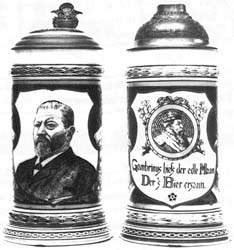 |
| Fig 1. Mettlach: 0.5L, #1997; 0.5L #1861. |
It has been common for breweries to contract with beer stein manufacturers for the production of steins bearing the brewery’s name, the brewer’s portrait, or the logo and other objects associated with a particular brewery. Mettlach produced “etched” steins for breweries in the United States and Argentina. The steins produced for U.S. breweries used existing molds. On three of the steins made for U.S. breweries, the center panel was changed to a P.U.G. portrait of the brewer. Decorative changes were also made to the side scenes on two of those steins. On another stein made for a U.S. brewery, only the inlay and thumblift were changed.
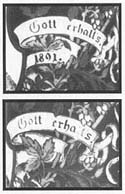 |
| Fig 2. Top - Mettlach #1997 with 1891 date; Bottom - #1997 without date. |
The most common etched U.S. brewery Mettlach stein is the George Ehret Brewery stein, form #1997. This stein used the basic body of form #1861. The style and coloration of the handle, upper and lower bands, base and frame around the P.U.G. portrait are the same. Even the coloration of the body, with grey stripes on top and bottom, is the same. The side scenes were changed from simple leaves and banner ribbon on form #1861 to a more complex barley, hops and banner design on form #1997.
The body form is also very similar to form #1794, the Bismarck stein, signed by Warth. The shape and coloration of the handle, base and bottom band are identical. The main portion of the upper band is also identical. Only the decorative edges are different. The edging of the center cartouche on form #1794 is simplified on the Ehret steins. The grey stripes on the top and bottom of the etched portion of the body are the same. However, the coloration and side scenes have been changed.
The Ehret stein, signed by Hein, was produced in two versions. One version commemorates the 25th anniversary of the brewery. It contains the dates 1866 and 1891 on the lower white banner on either side of the P.U.G. portrait of George Ehret. On the other version there is a hops leaf that covers the lower white banner on either side. These leaves on either side of the portrait were redesigned to uncover this banner on the anniversary version. Despite the two form versions, both of the versions I have in my collection were made in 1890. In all other respects, these versions are identical, having the same inlay, thumblift, coloring, portrait, bands and handle.
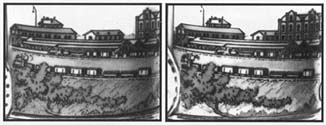 |
| Fig 4. Mettlach Quilmes Brewery steins, 0.5L, #2900: Left - Side view detail of stein dated 1904; Right - Same view of stein dated 1906. |
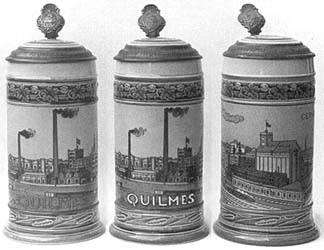 |
| Fig 3. Mettlach Quilmes Brewery steins, 0.5L, #2900: Left - 1903/4 version; Center - 1906 version; Right - 1929 version. |
Another common etched Mettlach stein which has several variations is the Quilmes brewery stein, form #2900. This body form was later used on the Car stein (form #3202). The Quilmes steins were produced with three entirely different etched scenes. The earliest version was first produced in 1903 or 1904. It is a view of the factory dominated by two large smokestacks. The company name Quilmes is in either bold red incised or relief letters at the bottom of the etched portion in the foreground of the scene. In 1906, a second version was produced. The “Quilmes” at the bottom of the stein was changed to raised white letters (see Figure 3). There was also a change in the scene to the left of the small smokestack (see Figure 4). On both versions, immediately above these letters, is a steam locomotive. At the back of the body of each version, on the left side of the handle, are the words Cerveceria Argentina (Argentine Brewery). The incised company logo is to the right of the handle.
The third version (after 1929) of the Quilmes stein depicts the apparently greatly expanded brewery. The point of view of the factory as depicted on the stein is different — the smokestacks have been shifted to the left of the scene and the size of the buildings has been reduced to permit the entire growing factory to be shown. The train has been updated and automobiles have been added. The bold-lettered QUILMES has been eliminated. On the side of the stein to the left of the handle is incised Cerveceria Argentina and Quilmes. To the right of the handle is the non-incised company logo. The remainder of the stein, including the handle, the upper body band of hops and the lower body band of barley, is identical in both versions.
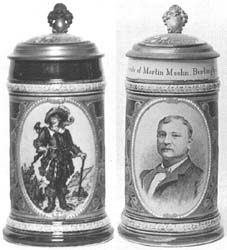 |
| Fig 6. Left - Mettlach, 0.5L, #1998, Trumpeter of Säkingen; Right - Mettlach, 0.5L, #1998, Martin Moehn Brewery. |
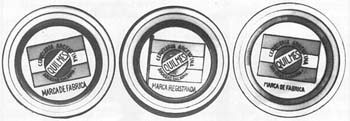 |
| Fig 5. Inlays for Mettlach Quilmes Brewery steins: Left and center - 1093 and 1906 versions, with and without flagpole; Right - 1929 versiom. |
The pewter rim around the inlay in all three versions has a presentation statement which includes an area for engraving the name of the recipient of the stein. There are three different inlays with minor variations. The inlays depict the company flag, either by itself or attached to a flagpole (see Figure 5).
Another brewery stein with variations is the Martin Moehn Brewery/Trumpeter of Säckingen stein, form #1998. The common version of this form contains an etched front panel of the cavalier known as the Trumpeter of Säckingen. On the sides are relief hops branches. The inlay is a walled castle on a mountaintop and a rose bush with three white roses in the lower left. In the rare version of this form number, a P.U.G. portrait of Martin Moehn replaces the etched front panel, and the dark glaze above the upper band is replaced with a colorless glaze over non-incised lettering reading Compliments of Martin Moehn, Burlington, Iowa. The rest of the stein, including the inlay and thumblift, remains unchanged.
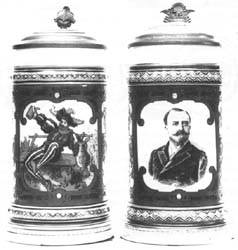 |
| Fig 7. Left - Mettlach, 0.5L, #1796; Right, Mettlach, 0.5L, #2136. |
The body of the Anheuser Busch stein, form #2136, consists of three panels. This stein appears to be a derivation of Mettlach form #1796. The handles of both steins are identical, as are the upper and lower body bands and the base. The brown frame around the center panel is also identical, but the etched cavalier of Mettlach form #1796 is replaced by the P.U.G. portrait of Adolphus Busch. The top and sides of the frames of each of the two side panels are also identical, including the shelves and pouring steins depicted on each side panel. Only the bottom of each side panel is changed, the monkey and the cat on form #1796 being eliminated and the bottom frame being simplified to permit the inclusion of etched verses and other material on the Busch stein.
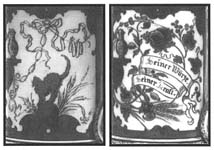 |
| Fig 8. Side scenes from Mettlach #1796 and #2136. |
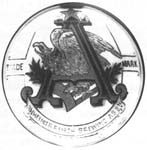 |
| Fig 9. Inlay for Mettlach #2136 and A-B version of #1968. |
Anheuser-Busch had another stein made by Mettlach, for which they used the .3L version of form #1968, known as The Lovers. In this variation, they used the same body and changed the inlay and thumblift, using a smaller version of the
Anheuser-Busch inlay from form #2136 and the United States shield thumblift depicting a spread-winged eagle perched on a shield with arrows and an overhead banner saying E Pluribus Unum. This is the same thumblift used on form numbers
1997 and 2136.
__________
*Reprinted from The Beer Stein Journal, November 1994, by permission from Gary Kirsner Auctions.










